Game Development of “Prokes” to Socialize the Prevention of Covid-19
on
JURNAL ILMIAH MERPATI VOL. 9, NO. 2 AUGUST 2021 p-ISSN: 2252-3006
e-ISSN: 2685-2411
Game Development of “Prokes” to Socialize the Prevention of Covid-19
Dewa Ayu Indah Cahya Dewia1, Ngakan Putu Darma Yasaa2 aProgram Studi Teknik Informatika, STMIK STIKOM Indonesia Jl. Tukad Pakerisan No. 97 Denpasar, Bali, Indonesia e-mail: 1cahya.dewi@stiki-indonesia.ac.id, 2darma.yasa@stiki-indonesia.ac.id
Abstrak
Tingkat kesadaran masyarakat Indonesia untuk tertib dan mematuhi protokol kesehatan masih sangat rendah. Sentuhan khusus kepada kaum muda diperlukan dalam mensosialisasikan protokol kesehatan dan kehidupan normal yang baru. Game “Prokes” diharapkan dapat menjadi sarana sosialisasi pencegahan Covid-19. Metode yang diusulkan adalah metode agile yang dikombinasikan dengan algoritma shuffle random untuk mengacak soal dalam kuis game ini. Hasil blackbox adalah 100% fungsionalitas game telah berjalan dengan baik. Ada perbedaan yang signifikan antara pengetahuan pengguna sebelum dan sesudah bermain game “Prokes” yang ditunjukkan dengan nilai t tabel 2,004, nilai t 2,297, dan nilai kritis α = 0,05. Metode yang diusulkan memiliki tingkat keterlibatan 3,04. Oleh karena itu, permainan layak dianggap sebagai sarana sosialisasi dalam pencegahan Covid-19 dengan menggunakan protokol kesehatan dan normal baru bagi generasi muda.
Kata kunci: Protokol Kesehatan, Covid-19, Game, Agile, Algoritma Shuffle Random
Abstract
The level of awareness of the Indonesian people to orderly and comply with the implementation of health protocols is still very low. Special touch to young people is needed in socializing health protocols and new normal life. Game of “Prokes” is expected as a means for socialization of covid-19 prevention. The proposed method is agile method that is combined using shuffle random algorithm to randomize question in quiz of this game. The blackbox result was 100% functionality of the game has run well. There was a significant difference between user knowledge before and after playing the game of “Prokes” as indicated by t value of 2.297, t table value of 2.004, and the critical value of α = 0.05. The proposed method had an GEQ result of 3.04. Therefore, the game feasible as a means of socialization in prevention covid-19 using health protocols and new normal for the young generations.
Keywords : Health Protocol, Covid-19, Game, Agile, Shuffle Random Algorithm
COVID-19 has now become a pandemic outbreak that has spread to almost all countries. Various kinds of preventive measures have been attempted to prevent the spread of the COVID-19 epidemic, such as lockdowns in several countries, regional quarantine, work from home, diligently washing hands with soap, using masks for coughing and avoiding gathering with crowds. Based on the results of the Nielsen and UNICEF survey, it is stated that the level of awareness of the Indonesian people to orderly and comply with the implementation of health protocols is still very low. One of the keys to preventing the Covid-19 outbreak from spreading, for now it is enough to tighten the implementation of health protocols [1]. From a survey conducted in six cities, namely Jakarta, Bandung, Surabaya, Medan, Makassar and Semarang, it shows that only 31.5 percent of the orderly and fully compliant to the health program [2]. The latest BPS survey in April 2020 also revealed that women are more obedient than men when implementing the Covid-19 health protocol, whether it's using a mask, maintaining distance, or washing hands. People who are older are also much more obedient. So there is a tendency for
the younger community to slightly less adhere to health protocols, so this needs to be taken into account when conducting outreach. So it needs a special touch to young people, of course, in ways that are more relevant to them. For instance, interactive media, video, animation, game, augmented reality and others. Use of game theory to improve user interaction on the system [3].
This research discuses game as means for socialization of covid-19 prevention by implementing health protocols during pandemic and new normal life. The proposed method of this research is agile method for developing game that will be combined with shuffle random algorithm to randomize the questions of the quiz. The user target of the game is children until adults based on The Indonesian Internet Service Providers Association (APJII)’s data, 16.5 percent of the public chose to play online games as entertainment during the Covid-19 pandemic. Based on data from Statista in 2020, there were 50.8 million mobile game users. This is the impact of the study at home and work from home (WFH) policy. As a result, the use and download of online game applications has increased, and is even predicted to increase by 21.6 percent in 2025.
The authors refer to some studies that are conducted by Jody Sukma Atmadja in 2018 about developing game of “Dendam ledok” using agile game development. Dendam ledok is a garbage sorting game, where the players will put garbages according to its type within the time limit that has been determined [4]. Another research conducted by Anastasya Latubessy in 2017 discuss about developed a game addiction analysis model using backward chaining with validity testing value of 0.78 which means having a strong agreement [5]. The research that was conducted by Amelia Yusnita et al in 2019 using shuffle random algorithm to randomize the questions in five senses learning [6]. Another research that was conducted by Brockmyer et al in 2013 show that Game Engagement Questionnaire (GEQ) to measure player characteristic in determining game influence [7].
This research urgency is socializing the prevention of covid-19 using health protocols during pandemic and new normal using interactive media, namely game of “Prokes”. Discipline and awareness in using health protocols need to be instilled from an early age, that is from childhood.
The game development method contains 3 processes, namely pre-production, production and post-production. In pre-production consists of 2 phases, namely concept development and design. The production stage is the stage of making game program code. At this stage, a random shuffle algorithm is also inserted to randomize the questions in the game. The post-production stage is the game testing stage which includes alpha testing, t-test and GEQ.
Agile method is a method of developing software in a relatively fast time and does not consume large resources, besides that changes can be made quickly according to client needs [8], [9]. The agile method is not suitable when done in teams of more than 20 people Agile game development is a software development method using an agile approach in developing game applications [10]–[12]. The application of the agile method in developing mobile applications, especially games, consists of 6 phases. The brainstorm phase contains problem analysis, game concepts and ideas. The design phase contains the application design and prototype. The development phase consists of creating an application and iterating changes to the application. The quality analysis phase is in the form of testing to identify bugs and errors which are usually carried out by the tester and QA team. If there are bugs, then improvements are needed in the development phase. If there are no bugs, then the test is carried out by the client. After testing, then the client provides input / feedback. Based on feedback, the client decides to make changes or not. If a change is needed, then iteration of changes is carried out in the development and quality analysis phases. Game improvements continue until the client approves the game and the game is prepared to be sent to the client and launched. The stages of the agile method can be seen in Figure 1.

2.
Design
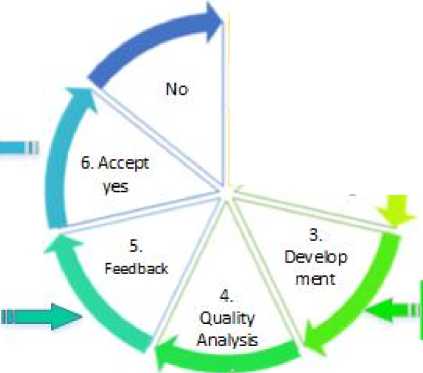
Requirement ana lysis
BuiW game and Iteration
de ntify bugs
1.
Br3 r≡toτπ

Design game
Figure 1. Agile Methodology for Game Development
The shuffle random algorithm is an algorithm used to randomize the index sequence in an array [14], [15]. The shuffling process is like shuffling cards. For example, A is an array of 5 x 1 size, which contains data A = [1,2,3,4,5], the shuffle random algorithm will randomize the array index sequence to A1 = [5,2,4,1,3] or other index sequence. An illustration of shuffling arrays can be seen in Figure 2.
12345 -52413
Figure 2. Illustration
In this study, the shuffle random algorithm was applied in the process of randomizing the questions in game level 5. There are 20 kinds of questions to be randomized in this game. Application of the random shuffle algorithm as a game variation to reduce boredom of game users.
This section, we will describe some previous research related to this research. Ni Kadek Yuliastin’s research in 2016 discuss about educational games of Balinese Dance clothing using the Lua programming language with aspects entertainment 60% good value and 40% very good value. The stages of develop the game, namely Game Design Requirements, Game Design and Testing, and Implementation [13]. The research conducted by I Gede Teguh Pribadi in 2017, Tower Defense game "Defense of the Gods Island" is a game whose characters and stories are adapted from Balinese culture. The test results have an average feasibility rate of up to 85%. There are 4 stages for developing game, namely literature study, game design and interface, implementation into code and testing [14]. The research in 2017 by Dewa Putu Yudhi Ardiana and I Dewa Gede Agung Pandawana discuss about the development of the Balinese Folklore Game Application with a waterfall model through analysis, design, code and test phase [15]. In contrast to previous research, this study discusses game development using agile methodology combine with shuffle random algorithm and game testing using t-test and GEQ.
This section, we will describe the process of brainstorm, design, development and the implementation result of “Prokes” using agile game development and shuffle random algorithm.
The phases in developing “Prokes” game using agile approach and shuffle random algorithm that is.
In this brainstorm phase is process to find solution from some problem.
-
a. Requirement and problem analysis
Based on the results of a survey by Nielsen and UNICEF, it is stated that the level of awareness of the Indonesian people to orderly and comply with the implementation of health protocols (prokes) is still very low. In april 2020, BPS survey also revealed that women are more obedient than men when implementing the Covid-19 health protocol, whether it's wearing a mask, maintaining distance, or washing hands. People who are older are also much more obedient. So there is a tendency for the younger community to slightly less adhere to health protocols, so this needs to be taken into account when conducting outreach. So it needs a special touch to young people, of course, in ways that are more relevant to them, for instance, interactive media, animation, audio, game and video.
-
b. User characteristic and learning objective
Based on that problem, the students of elementary school to university as target users of this game. The learning will be contained what is covid-19, how to prevent covid-19 and what does the new normal mean.
-
c. Game idea
The game idea is to help male character named Putu and female character named Made to apply new normal life during pandemic by take care of health, wear masks and physical distancing.
In this phase, started with design application and prototype process. The general purpose of the game is user can know the right step washing hands, wearing a mask, physical distancing and apply health protocol in new normal.
-
a. Story setting and character
This game will ask user to remind Putu and Made to apply health protocol when going outside during pandemic.
-
b. Combat and scoring system
This game type is single player. Every level has different time limit. The score is calculated by how fast user complete this game by choosing right decision in apply health protocol during pandemic and new normal life.
-
c. Controller system
The objects that can be controlled by user are healthy food, masks, hand sanitizer, and other health protocol equipment. For controlling object in this game by drag health protocol equipment and click the right answer in quiz section.
-
d. Localization plan
This game aim to Indonesian people so that, uses an Indonesian language.
-
e. Interface and level detail
In designing interface and level detail can be seen in screen flow of the game in Figure 3. Figure 3 show the flow of user play the game, if user complete playing game in previous level, user can continue playing the next level.
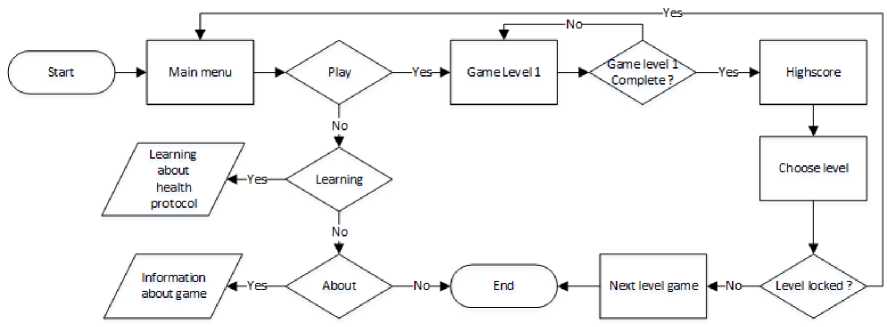
Figure 3. Screen flow of the game
The following are some interface of “prokes” game.
-
1. Main menu screen
User can play the game by click on play button, how to play the game can be seen by clicking on about button. Sub menu learn to give information about covid-19, health protocol and new normal life. Main menu screen can be seen in Figure 4.
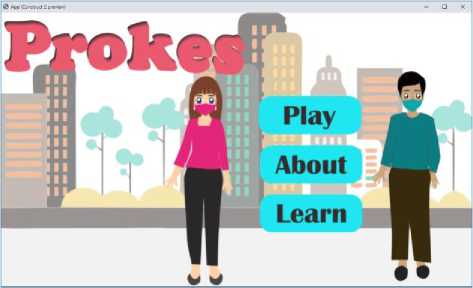
Figure 4. Main menu screen
-
2. Level screen
Figure 5 show that level of this game consist of 5 levels with the different problem in each level. Users cannot play the next level of the game without completing the previous level.
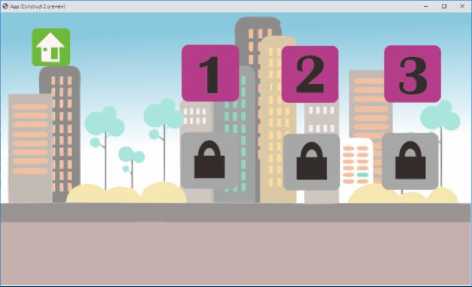
Figure 5. level screen
-
3. Health protocol equipment screen
Figure 6 show about some health protocol equipment usually use during pandemic. There are masks and hand sanitizer which is used when outside. User can drag the health protocol equipment as needed.
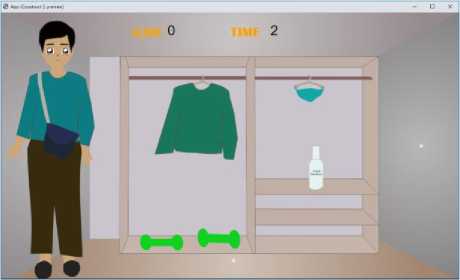
Figure 6. Health protocol
-
4. Storyline screen
A few stories about how to protect the character from covid-19 when inside is shown in Figure 7 and when outside is shown in Figure 8. In figure 7, user can drag some healthy food and drop on character. In figure 8, the character can be drag to keep social distancing and dragging the masks to each character.
® ⅛p SQftsowtIp-We-I — □ X
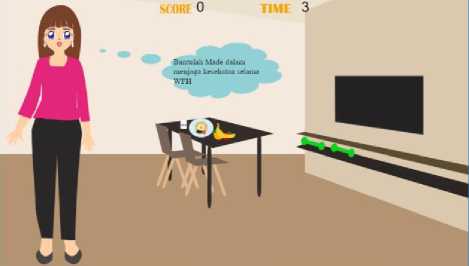
Figure 7. When inside
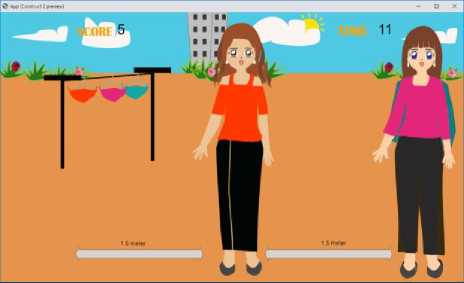
Figure 8. When outside
-
5. Quiz screen
Figure 9 show about the quiz of the game. This quiz consists of 20 questions which is randomized by shuffle random algorithm. This screen consist timer. If user choose wrong answer, the score will be decreased.
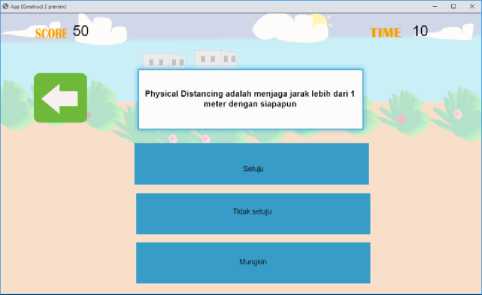
Figure 9. Quiz
Users can see the score and highscore after completing the game in every level that can be seen in Figure 10. Highscore is user’s highest score has ever achieved at each level.
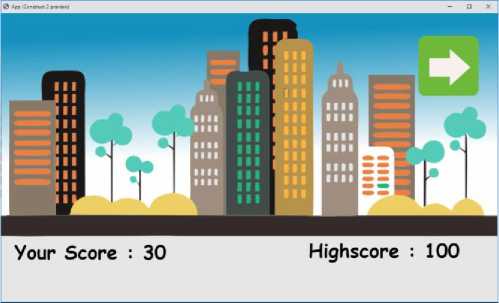
Figure 10. Highscore
The “prokes” game is made using Construct 2. Construct 2 can publish multiplatforms games, namely android, ios and web based platform. This phase, shuffle random algorithm is implemented in the game to randomize questions about covid-19, health protocol and new normal. The quiz is multiple choice. The question file is imported in this phase as shown in Table 1.
Table 1. Question in the quiz
No Question
-
1 What are the common symptoms of Covid-19 ?
-
2 How is COVID-19 transmitted ?
-
3 What is the scientific name of the corona virus?
-
4 A test for COVID-19 which is done by taking a blood sample is called
-
5 Lockdown in Indonesian is called
-
6 Example of physical distancing ?
-
7 When should a mask be worn ?
-
8 What is physical distancing
-
9 Can washing hands protect yourself from COVID-19?
-
10 Personal protective equipment during a pandemic ?
-
11 How to protect yourself from covid-19 ?
-
12 What do you bring when hang out with friends during pandemic ?
-
13 Can I go to the beach ?
-
14 Can I go to the market ?
-
15 Place to buy eggs to the market or to a shop ?
-
16 When leaving for work using public transportation or private vehicles ?
-
17 How to wash your hands properly ?
-
18 How to use the correct health protocol ?
-
19 Can I take my child outside the house ?
20 Can COVID-19 be cured ?
Those questions are designed to encourage user to choose wisely during pandemic.
In this phase, we check the quality and the content of the game. Quality game is tested by alpha testing using blackbox method [16]. The functional game is testing to find out the bug and error of the game. Developing game using agile approach make game flexible in dealing with change. Quality game usually check by tester and QA (Quality Assurance) team. If there are some bug and need to change, the process to be continued to development phase. The changes in development phase continue until approval from tester and QA team. Then game is send and check by client again. The result of blackbox method can be shown in Table 2.
|
Table 2. Blackbox testing result | |
|
Testing scenario |
Expected result Testing result |
|
Testing all button in main menu screen |
Display level screen when click play button, display success the instruction when click about button and display information about covid-19, health protocol and new normal. |
|
User started playing the game |
All level are locked except first level success |
|
Drag and drop object |
The object can be dragged and dropped on the success character |
|
Randomizing questions |
20 questions in quiz section are randomized after success answer the question |
|
Score and highscore |
If choose wrong answer, the score is decreased, if success choose right answer, the score is increased. After completing every level, the score and highscore are displayed. |
Game content is tested using t-test and GEQ (Game Engagement Questionnaire). T-test is used to find out the positive impact of this game on the user [17]. The engagement between game and user is calculated using GEQ [18]. There are 55 millennial respondents with age 1820 years old. T-test result can be seen in Table 3.
Table 3. T-test result
|
Variable |
Total score | |
|
Before |
After | |
|
Average/mean |
66.0 |
68.6 |
|
Deviation standard |
22.4 |
23.9 |
T-test result show that t table value of 2.004, t value of 2.297 and critical value of α=0.05 then t value > t table that means there was the difference user knowledge before playing the game and after playing the game.
Game engagement questionnaire (GEQ) is divided into 4 part namely flow, absorption, immersion and presence. The flow result is shown in Table 4. The immersion result is shown in Table 5. The absorption result is shown in Table 6. The presence result is shown in Table 7. GEQ use likert scale. GEQ measures the user's psychological when playing games, and predicts the negative impact of games. The GEQ result is shown in Table 8.
|
Table 4. Flow result | ||
|
Statement |
Mean |
Deviation Standard |
|
I don't want to stop playing this game |
3.4 |
1.14 |
|
When playing this game, I can't answer when someone talks to me |
2.87 |
1.37 |
|
playing this game can make me feel calm |
3.58 |
0.97 |
|
while playing this game, I can't hear someone talking to me |
2.27 |
1.36 |
|
This game looks real |
3.56 |
1.03 |
|
I'm not tired of playing this game |
3.74 |
1.20 |
|
I'm not bored playing this game |
3.50 |
1.15 |
|
I won't uninstall this game |
3.14 |
1.00 |
Flow describes the feeling of pleasure that occurs when a balance of skills and challenges is achieved [19]. The average of flow value was 3.25 greater than deviation standard which means mean value can be used as a representation of the entire data. Flow value show that game users feel enough pleasure.
-
Table 5. Immersion result
Statement Mean Standard
deviation
I really get into the game 3.03 1.17
Immersion describes the engagement in playing game while defending awareness of the environment [20]. The average of immersion value was 3.03 greater than deviation standard which means mean value can be used as a representation of the entire data. This show that game users are at the average level of getting into the game.
|
Table 6. Absorption result | ||
|
Statement |
Mean |
Standard deviation |
|
A lost track of where I am |
1.74 |
1.02 |
|
I'm not confused about playing this game |
3.8 |
1.14 |
Absorption refers to a condition of full concentration and dissolves deeply when playing games so that time runs quickly and finds it difficult to get away from playing games. The average of absorption value was 2.77 greater than deviation standard which means mean value can be used as a representation of the entire data. Absorption value was 2.77 below a scale of 3 show that user do not dissolves deeply when plaing game. This also show that the improvement of game is needed, eventhough the absorption value that is too high is not good for game users.
|
Table 7. Presence result | ||
|
Statement |
Mean |
Standard deviation |
|
I play longer than I meant to |
2.56 |
1.22 |
|
My thoughts go fast |
3.83 |
1.01 |
|
I lost track of time |
2 |
1.15 |
|
Playing this game is like a habit every day |
2.61 |
1.28 |
Presence describe about being normal in consciousness as well as having the experience of being in a virtual environment during playing game [21]. The average of presence value was 2.75 greater than deviation standard which means mean value can be used as a representation of the entire data. Presence value of 2.75 below a scale of 3 show that user still being normal in consciousness without losing time. This also show that the improvement of game is needed, eventhough the presence value that is too high is not good for game users.
Table 8. GEQ result
Method Engagement rate Standard
(GEQ) deviation
Agile + Shuffle random 3.04 1.32
The GEQ result show that engagement rate is still normal can be seen from the engagement rate of 3.04 in range 1 to 5. This show that engagement rate is good enough, neither too good nor too bad. The GEQ result of 3.04 greater than deviation standard which means GEQ value can be used as a representation of the entire data.
Some feedback from client is needed to improve the game until the game according to market needs. Feedback to change and add features before game is released. Some feedback can be seen in Table 9.
Table 9. Feedback
No Feedback
-
1 Maybe Given Instructions or Explanations at Each Level, Before I tried the game,
I was a little confused about what to do.
-
2 Music is needed to give the game atmosphere
-
3 Nothing needs to be changed
Approval from client is required to launch the game. As long as game has not been approved by the client, the iteration process to change and add features continues. Iteration process can be seen in Figure 11.
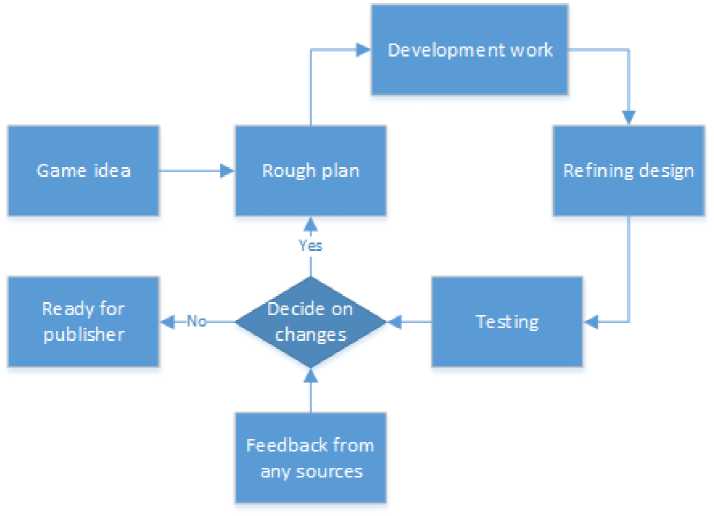
Figure 11. Iteration process
Agile methodology combine with shuffle random algorithm can be implemented for developing game. There was an enhancement in user’s knowledge after playing a game that can be seen from t-test result with t table value of 2.004, t value of 2.297 and critical value of α=0.05, so that it can be used as a means of socializing new normal life and health protocols starting early, namely childhood. Based on GEQ value of 3.04, the game does not have
negative effects such as excessive addiction and user awareness between the surrounding environment and the virtual environment of the game when playing the game is still normal.
References
-
[1] M. N. Aly et al., “PANDUAN AMAN ‘NEW NORMAL’ MENGHADAPI PANDEMI COVID-
-
19.” Jurnal Layanan Masyarakat (Journal of Public Services). 2020. doi: 10.20473/jlm.v4i2.2020.415-422.
-
[2] D. Ambarita, “Senior 50-54 Tahun Paling Disiplin Terapkan 3M,” https://ubahlaku.id/,
Medan, Nov. 06, 2020.
-
[3] S. Supriyanto and J. Fahana, “Gift-exchange Game Theory for Gamification on Digital
Data Collection Systems.” Lontar Komputer: Jurnal Ilmiah Teknologi Informasi. 2020. doi: 10.24843/lkjiti.2020.v11.i01.p06.
-
[4] J. S. Atmadja, “Pembangunan Game Peduli Lingkungan Menggunakan Metode Agile
Game Development.” 2018.
-
[5] A. Latubessy and E. Wijayanti, “MODEL IDENTIFIKASI KECANDUAN GAME
MENGGUNAKAN BACKWARD CHAINING.” Simetris: Jurnal Teknik Mesin, Elektro dan Ilmu Komputer. 2017. doi: 10.24176/simet.v8i1.807.
-
[6] A. Yusnita and T. Rija’i, “Implementasi Algoritma Shuffle Random pada Pembelajaran
Panca Indra Berbasis Android.” JUITA: Jurnal Informatika. 2019. doi: 10.30595/juita.v7i1.3647.
-
[7] C. M. Fox and J. H. Brockmyer, “The Development of the Game Engagement
Questionnaire : A Measure of Engagement in Video Game Playing : Response to Reviews.” Intercting With Computers. vol. 25, no. 4. pp. 3–6. 2013. doi: 10.1093/iwc/iwt003.
-
[8] M. McCormick, “Waterfall and Agile Methodology.” MPCS Inc. 2012.
-
[9] V. Upadrista, “Agile Methodology,” in The Art of Consultative Selling in IT, 2015.
-
[10] C. Keith and M. C. Kent Beck and Martin Fowler, Consulting Editors, Agile Game
Development with Scrum. 2010.
-
[11] H.-R. Ruonala, “Agile Game Development: A Systematic Literature Review,” 2017.
-
[12] A. Godoy and E. F. Barbosa, “Game-Scrum: An Approach to Agile Game Development,” 2010.
-
[13] N. K. A. W. Ni Kadek Yuliastin, I Made Sukarsa, “Aplikasi Game Edukasi Busana Tari Bali Pada Smartphone Berbasis Android.” Merpati. vol. 2. pp. 280–290. 2016. doi: 10.24843/JIM.
-
[14] I. G. Teguh Pribadi, A. A. K. Agung Cahyawan Wiranatha, and P. Wira Buana, “Rancang Bangun Game Tower Defense ‘Defense of Dewata Island’ Berbasis Android.” Jurnal Ilmiah Merpati (Menara Penelitian Akademika Teknologi Informasi). 2017. doi: 10.24843/jim.2017.v05.i03.p05.
-
[15] D. P. Y. Ardiana and I. D. G. A. Pandawana, “Aplikasi Game Cerita Rakyat Bali Sebagai Sarana Pendidikan Karakter Anak Berbasis Mobile.” Lontar Komputer: Jurnal Ilmiah Teknologi Informasi. 2017. doi: 10.24843/lkjiti.2017.v08.i03.p07.
-
[16] E. Sudarmilah, E. Sudarmilah, N. Ustia, and D. N. Bakhtiar, “Learning Media based on Augmented Reality Game.” International Journal of Engineering & Technology. 2019. doi: 10.14419/ijet.v8i1.1.24653.
-
[17] N. A. M. Zin and W. S. Yue, “Design and evaluation of history Digital Game Based Learning (DGBL) software.” Journal of Next Generation Information Technology. 2013. doi: 10.4156/jnit.vol4.issue4.2.
-
[18] J. H. Brockmyer, C. M. Fox, K. A. Curtiss, E. McBroom, K. M. Burkhart, and J. N. Pidruzny, “The development of the Game Engagement Questionnaire: A measure of engagement in video game-playing.” Journal of Experimental Social Psychology. 2009. doi: 10.1016/j.jesp.2009.02.016.
-
[19] H. Pratiwi, I. Arfyanti, and M. Z. Sururi, “Membangun Game Edutainment ‘Pengenalan Komputer’ Menggunakan Shuffle Random (SR) Dan Finite State Machine (FSM) Untuk Anak Tunagrahita Ringan.” J-SAKTI (Jurnal Sains Komputer dan Informatika). vol. 3, no. 2. p. 307. Sep. 2019. doi: 10.30645/j-sakti.v3i2.149.
-
[20] P. Krebs, J. E. Burkhalter, B. Snow, J. Fiske, and J. S. Ostroff, “Development and alpha testing of quitit: An interactive video game to enhance skills for coping with smoking
urges.” Journal of Medical Internet Research. 2013. doi: 10.2196/resprot.2416.
-
[21] H. Ashraf, F. G. Motlagh, and M. Salami, “The Impact of Online Games on Learning English Vocabulary by Iranian (Low-intermediate) EFL Learners.” Procedia - Social and Behavioral Sciences. 2014. doi: 10.1016/j.sbspro.2014.03.418.
Game Development of “Prokes” to Socialize the Prevention of Covid-19 (Dewa Ayu Indah 187
Cahya Dewi)
Discussion and feedback